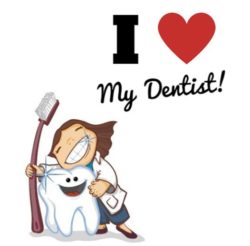Dentistry
Dentysta stomatolog Warszawa Ursynów ADENTIS / Services / Dentistry
The tooth should look like a tooth, to work like a tooth
At ADENTIS, all general medical and dental procedures are aimed at helping and solving the patient’s problem as best as possible.
- Our motto is the highest quality of services, which is why we use modern technologies and constantly improve our qualifications.
- We make every effort to ensure that the desired health and aesthetic effect is lasting, because our goal is complete patient satisfaction.
- The patient’s well-being is the most important thing to us.
Our motto is above all, do no harm. The treatment cannot be worse than the disease, which is why at Adentis, before treatment, the patient is diagnosed and thoroughly examined. The examination involves taking overview X-rays: panoramic radiograph, digital camera photos of teeth, examination of the temporomandibular joints, examination of the facial muscles.
Each patient is presented withORAL HYGIENE INSTRUCTION.
Because following proper oral hygiene eliminates existing problems and minimizes the occurrence of tooth decay, and prevents gum disease.
Treatments at ADENTIS
- Oral examination and dental examination
- Dental check-up
- Caries treatment
- Treatment of cervical defects
- Occlusion and articulation analysis
- Individual oral hygiene instruction
- Oral hygiene – teeth cleaning (scaling and sandblasting)
- Treatment of hypersensitivity of individual teeth
- Filling or reconstruction of worn tooth surfaces with composite materials
- Root canal treatment (endodontic treatment) under a microscope
- Reconstruction of missing teeth (bridges, implants)
Painless dental treatment under anesthesia
Conservative dentistry is a surgical specialty dealing with the prevention and treatment of caries. The most common cause of toothache is tooth decay.
Caries treatment is usually a one-visit, painless procedure under local anesthesia and aims to:
- Inhibition of caries development
- Prevention of caries recurrence
- Reconstruction of damaged tooth tissues
- Preservation of living, healthy pulp
We have dental cameras at each unit. Nowadays, an intraoral camera is an ideal tool for cooperation between doctors and patients. It allows you to visualize the progress of the treatment process, and thus helps reduce the stress associated with the procedure, and can also effectively increase the acceptability of the treatment by patients and, which is no less important for the patient’s comfort, reduces misunderstandings between the patient and the doctor.
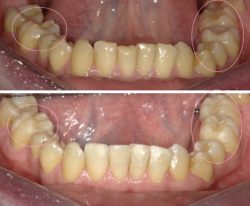 |
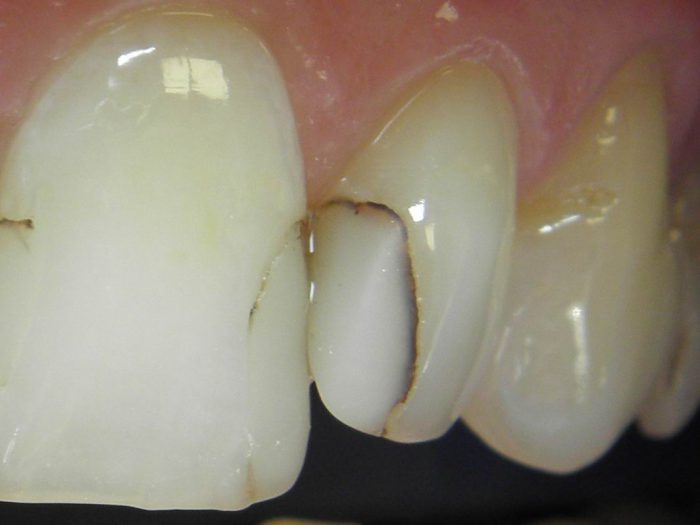 |
 |
 |
| Secondary caries | Remove old fills | Aesthetic fill |
Reconstruction of lost tooth fragments
In emergency cases of tooth fracture, we are always ready to help the patient. If possible, we rebuild the tooth in one visit using glass ionomer and composite materials. Depending on the clinical situation, we use appropriate materials and solutions.
Tooth injury. Adhesive tooth reconstruction, while maintaining proper articulation and occlusion, is the least invasive method of rebuilding lost tooth tissue. This procedure is an alternative to prosthetic restorations, such as crowns. The patient’s hard tissues should always be respected and treatment should be planned as minimally invasive as possible. Nature is the best form of treatment, any restoration will be inferior to the natural form of the tooth.
Currently, we have filling materials that can be completely invisible, even under ultraviolet light at discos or in the light of TV cameras. Making such aesthetic fillings is possible thanks to the use of materials imitating individual tooth tissues, applied in layers. They are available in a huge number of colors, and individual colors can also be mixed with each other, which allows the creation of fillings that imitate tooth tissue that has been injured.
 |
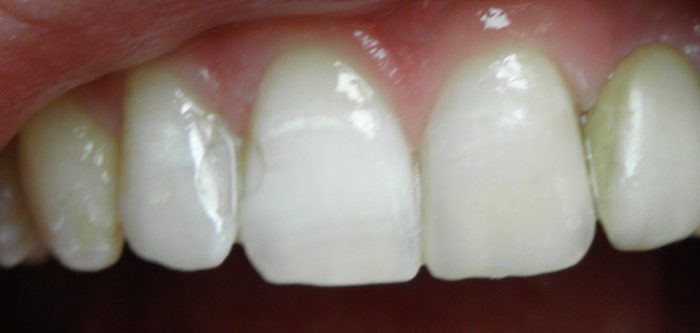 |
| Tooth injury | Adhesive tooth restoration |
Breakage of part of a tooth due to trauma.
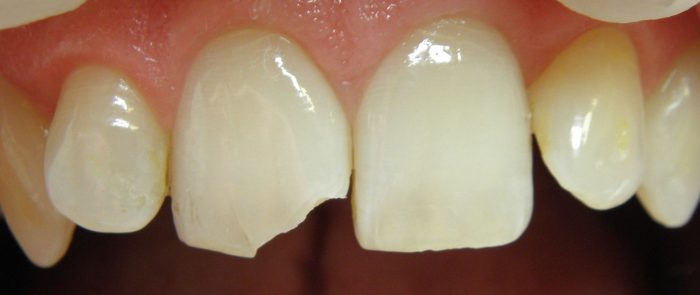 |
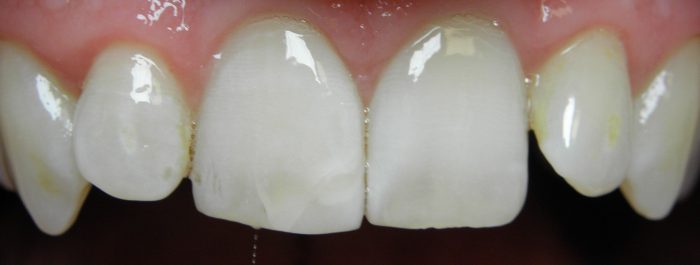 |
| Tooth injury | Gluing the broken fragment |
What are exposed tooth necks? Tooth hypersensitivity

In approximately 20-50% of people, the gums begin to recede at some point in their lives and expose the tooth necks (the junction between the tooth crown and the root). The teeth become “longer” and respond with pain to touch, sweet and sour taste, and heat and cold. The result is tooth pain when brushing, eating, drinking, and sometimes even breathing. These symptoms were once thought to be mainly the result of improper tooth cleaning: using a hard toothbrush, abrasive toothpastes or pressing the toothbrush too hard against the tooth surface while brushing, which leads to abrasion of the thin layer of cement located on the surface of the tooth necks. As a result, sensitive dentin and the pain-conducting tubules running within it are exposed.
It is now known that occlusal problems cause the necks of the teeth to become exposed, which leads to pain. Only the elimination of occlusal obstacles will prevent further destruction of the gums and bone around the tooth.
Cervical (sphenoidal) defects
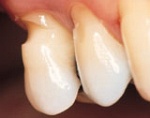
More and more people suffer from progressive receding gums and the formation of cervical lesions of non-carious origin, which are attributed to many causative factors:
- abnormal short-circuit loads are becoming increasingly important
- incorrect tooth contacts in malocclusion
- bruxism – pathological grinding or clenching of teeth
- not replaced missing teeth,
- using inappropriate toothpastes with high abrasiveness, especially whitening toothpastes that are actually abrasive toothpastes and not whitening toothpastes
- using hard toothbrushes
- improper oral hygiene
- sour diet
Regardless of the source of the problem, the final symptom is the same – exposure of the tooth root. An unprotected root is quickly dissolved by acids from food, which causes the formation of cervical cavities. In the past, this type of defects were difficult to treat because it was difficult to glue the filling material around the neck.
In about 20 percent of people, the gums begin to recede at some point in their lives, exposing the tooth necks (the junction between the tooth crown and the root). The teeth become “longer” and respond with pain to touch, sweet and sour taste, and heat and cold. The result is tooth pain when brushing, eating, drinking, and sometimes even breathing. These symptoms are mainly the result of improper tooth cleaning: using a hard toothbrush, abrasive toothpastes or pressing the toothbrush too hard against the tooth surface while brushing, which leads to abrasion (abrasion) of the thin layer of cement located on the surface of the tooth necks. As a result, sensitive dentin and the pain-conducting tubules running within it are exposed.
Additionally, exposed tooth necks are particularly susceptible to caries. This is because bacterial acids demineralize not only the enamel of the tooth crown, but also the dentin. However, dental caries can be prevented. Special protection for exposed tooth necks. Proper oral hygiene is extremely important. Horizontal brushing of teeth and pressing the toothbrush too hard damages the gums and tooth necks. Additionally, it may lead to excessive abrasion of dentin and the formation of the so-called wedge defects. A soft toothbrush with rounded bristles should be used. You should replace your toothbrush regularly with a new one every 4-6 weeks. It is also important to use a paste with a low abrasion index (about 30 RDA) to avoid excessive abrasion of the dentin, which is softer than the enamel.
In case of any problems, you can seek help from the doctors in the ADENTIS office.
Exposed tooth necks
- Individual oral hygiene instruction
- Treatment of hypersensitivity of individual teeth
- Filling worn tooth surfaces with composite materials
Dr. Aleksandra Gabren

